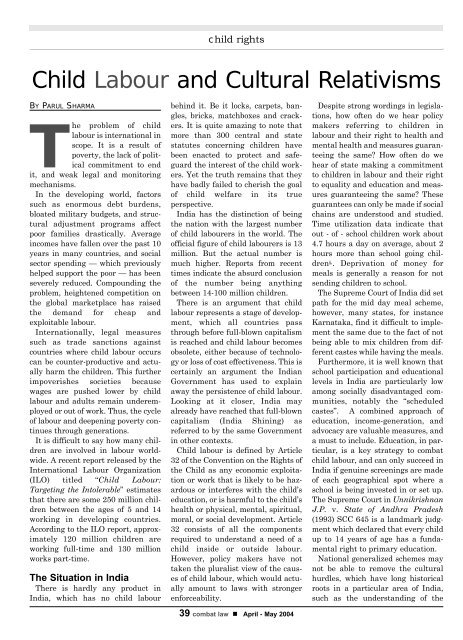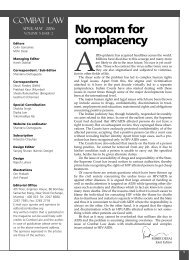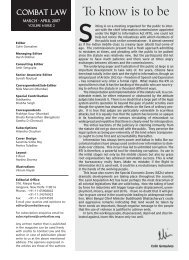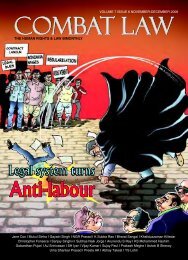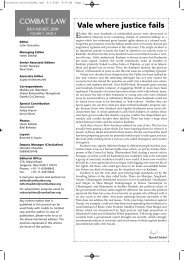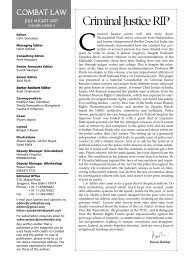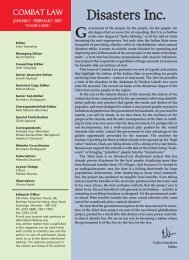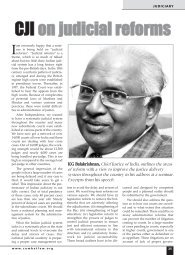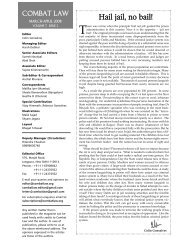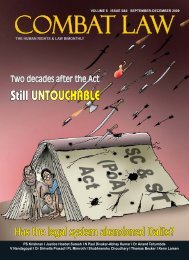PDF, 1.1MB - Combat Law
PDF, 1.1MB - Combat Law
PDF, 1.1MB - Combat Law
Create successful ePaper yourself
Turn your PDF publications into a flip-book with our unique Google optimized e-Paper software.
child rightsChild Labour and Cultural RelativismsBY PARUL SHARMAThe problem of childlabour is international inscope. It is a result ofpoverty, the lack of politicalcommitment to endit, and weak legal and monitoringmechanisms.In the developing world, factorssuch as enormous debt burdens,bloated military budgets, and structuraladjustment programs affectpoor families drastically. Averageincomes have fallen over the past 10years in many countries, and socialsector spending — which previouslyhelped support the poor — has beenseverely reduced. Compounding theproblem, heightened competition onthe global marketplace has raisedthe demand for cheap andexploitable labour.Internationally, legal measuressuch as trade sanctions againstcountries where child labour occurscan be counter-productive and actuallyharm the children. This furtherimpoverishes societies becausewages are pushed lower by childlabour and adults remain underemployedor out of work. Thus, the cycleof labour and deepening poverty continuesthrough generations.It is difficult to say how many childrenare involved in labour worldwide.A recent report released by theInternational Labour Organization(ILO) titled “Child Labour:Targeting the Intolerable” estimatesthat there are some 250 million childrenbetween the ages of 5 and 14working in developing countries.According to the ILO report, approximately120 million children areworking full-time and 130 millionworks part-time.The Situation in IndiaThere is hardly any product inIndia, which has no child labourbehind it. Be it locks, carpets, bangles,bricks, matchboxes and crackers.It is quite amazing to note thatmore than 300 central and statestatutes concerning children havebeen enacted to protect and safeguardthe interest of the child workers.Yet the truth remains that theyhave badly failed to cherish the goalof child welfare in its trueperspective.India has the distinction of beingthe nation with the largest numberof child labourers in the world. Theofficial figure of child labourers is 13million. But the actual number ismuch higher. Reports from recenttimes indicate the absurd conclusionof the number being anythingbetween 14-100 million children.There is an argument that childlabour represents a stage of development,which all countries passthrough before full-blown capitalismis reached and child labour becomesobsolete, either because of technologyor loss of cost effectiveness. This iscertainly an argument the IndianGovernment has used to explainaway the persistence of child labour.Looking at it closer, India mayalready have reached that full-blowncapitalism (India Shining) asreferred to by the same Governmentin other contexts.Child labour is defined by Article32 of the Convention on the Rights ofthe Child as any economic exploitationor work that is likely to be hazardousor interferes with the child’seducation, or is harmful to the child’shealth or physical, mental, spiritual,moral, or social development. Article32 consists of all the componentsrequired to understand a need of achild inside or outside labour.However, policy makers have nottaken the pluralist view of the causesof child labour, which would actuallyamount to laws with strongerenforceability.39 combat law • April - May 2004Despite strong wordings in legislations,how often do we hear policymakers referring to children inlabour and their right to health andmental health and measures guaranteeingthe same? How often do wehear of state making a commitmentto children in labour and their rightto equality and education and measuresguaranteeing the same? Theseguarantees can only be made if socialchains are understood and studied.Time utilization data indicate thatout - of - school children work about4.7 hours a day on average, about 2hours more than school going childreni. . Deprivation of money formeals is generally a reason for notsending children to school.The Supreme Court of India did setpath for the mid day meal scheme,however, many states, for instanceKarnataka, find it difficult to implementthe same due to the fact of notbeing able to mix children from differentcastes while having the meals.Furthermore, it is well known thatschool participation and educationallevels in India are particularly lowamong socially disadvantaged communities,notably the “scheduledcastes”. A combined approach ofeducation, income-generation, andadvocacy are valuable measures, anda must to include. Education, in particular,is a key strategy to combatchild labour, and can only succeed inIndia if genuine screenings are madeof each geographical spot where aschool is being invested in or set up.The Supreme Court in UnnikrishnanJ.P. v. State of Andhra Pradesh(1993) SCC 645 is a landmark judgmentwhich declared that every childup to 14 years of age has a fundamentalright to primary education.National generalized schemes maynot be able to remove the culturalhurdles, which have long historicalroots in a particular area of India,such as the understanding of the


